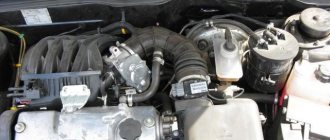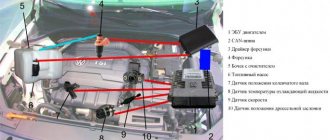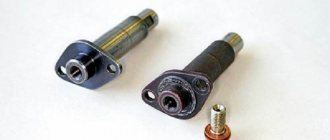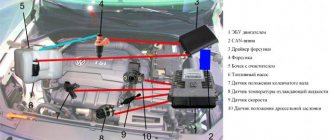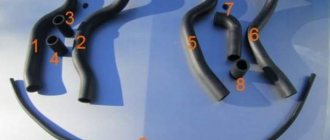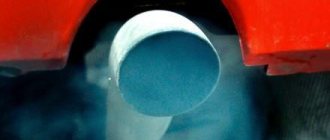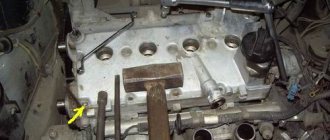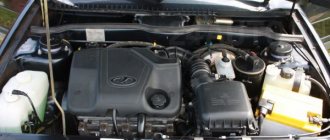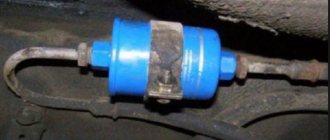History [edit | edit code]
VAZ-2115 became the first-born of the line codenamed “Samara-2”, after the Sputnik/Samara family, which became the most modified model of this family. This fact of modernization is confirmed by the fact that the VAZ-2115 has significantly changed the rear part of the car body. Namely the trunk lid, lighting devices. No similar transformations followed on the VAZ-2113 and VAZ-2114 cars. VAZ-2115 is a restyled model of VAZ-21099. The new model differed from its predecessor in the rounded shape of the hood and front fenders, trunk lid, new front and rear optics, bumpers painted in body color, trunk spoiler with an additional brake light, door sill fairings, door moldings, as well as a new interior and upgraded electrical equipment.
Initially, plans to modernize the Samara-2 line included changing not only the exterior of the body and trim, but also improving the suspension, transmission and braking system. However, ultimately, all these nodes were borrowed from the Samara-1 family without any significant changes. This made it possible to achieve a high degree of unification with the “ninth” family. The car received a more streamlined shape, thanks to which the angular outlines of the exterior, characteristic of the first generation Samar, are a thing of the past. Loading things into the trunk became much more convenient - now the loading height was at the level of the bumper. And a more advanced injection engine made it possible to develop more power, consume less fuel and warm up faster. In addition, the electronic engine control system monitored the level of exhaust toxicity.
VAZ 2115 diagram
Detailed color wiring diagrams for the VAZ 2115 (carburetor, injector) are provided with a description of the electrical equipment for various modifications. The information is intended for self-repair of cars. Many electrical circuits are divided into several sections for ease of viewing via a computer or smartphone; there are also circuits in the form of one picture with a description of the elements - for printing on a printer.
If you need to distribute power to external consumers (DVR, headlight washer, radio) when you turn on the ignition, it is better to take power from the battery through a relay. According to the scheme, 86 for the body, 85 for the ignition (for example, yellow-blue heater switch). Contact 30 through a 30 Amp fuse to the battery, 87 to consumers. That is, when you turn on the ignition, the new relay will turn on and the power will come directly from the battery.
Car modifications 2115
VAZ-2115 . The very first car that was produced since 1997. It was equipped with a 1.5-liter carburetor engine producing 76 horsepower. The maximum speed was 165 km/h, and the acceleration time from 0 to 100 km/h was 13.2 seconds.
VAZ-21150 . The next modification, released in 1998, was equipped with a 1.5-liter carburetor engine producing 68 horsepower. was discontinued in 2000.
VAZ-2115-20 . A modification of the car released in 2000, equipped with a 1.5-liter VAZ-2111 injection engine with a power of 77.8 horsepower. The maximum speed was 170 km/h, and the acceleration time from 0 to 100 km/h was 14 seconds.
VAZ-2115-40 . A modification with a 1.6-liter injection engine, which has been produced since 2003. The car's maximum speed was 158 km/h, and the acceleration time to 100 km/h took 13.2 seconds.
VAZ-2115-91 . A car with a 1.3-liter Wankel rotary piston engine producing 135 horsepower. The maximum speed is 190 km/h, and the acceleration time to 100 km/h is 9 seconds.
VAZ-21154 . The latest modification of the car with a new VAZ-11183 engine with a volume of 1596 cm3 and a power of 81 horsepower. Produced since 2007. The maximum speed and acceleration time to 100 km/h are exactly the same as that of the VAZ-2115-40.
Electrical diagram of VAZ-2115-01
Years of production 2115: 1997—2012. This is a circuit with a regular button for rear fog lights (with locking), a fluorescent interior light, a connector for the clock and an 8-pin connector for the injector wiring.
1 — block headlights; 2 — fog lights; 3 — air temperature sensor; 4 - generator; 5 — electric motor of the engine cooling system fan; 6 — fan motor activation sensor; 7 — engine compartment lamp switch; 8 — block for connection to a single-wire type audio signal; 9 — sound signal; 10 — oil level sensor; 11 — front brake pad wear sensors; 12 — washer fluid level sensor; 13 — spark plugs; 14 — ignition distributor sensor; 15 - switch; 16 — carburetor solenoid valve control unit; 17 — carburetor solenoid valve; 18 — carburetor limit switch; 19 — speed sensor; 20 - starter; 21 - battery; 22 — relay for turning on fog lights; 23 — coolant level sensor; 24 — brake fluid level sensor; 25 — reverse light switch; 26 — coolant temperature indicator sensor; 27 — engine compartment lamp; 28 — windshield wiper gearmotor; 29 — oil pressure warning lamp sensor; 30 — block for connecting to the rear window washer electric motor; 31 — electric motor for windshield washer; 32 — ignition coil; 33 — instrument cluster; 34 — mounting block; 35 — brake light switch; 36 — blocks connected to the injection system wiring harness; 37 — ignition switch unloading relay; 38 — ignition switch; 39 — glove box lighting lamp; 40 — switch for the glove compartment lighting lamp; 41 — rear window heating switch; 42 — fog light switch; 43 — fog light switch; 44 — external lighting switch; 45 — alarm switch; 46 — steering column switch; 47 — instrument lighting regulator; 48 — hydraulic corrector scale illumination lamp; 49 — socket for a portable lamp; 50 — side direction indicators; 51 — switches in the front door pillars; 52 — lamp for individual interior lighting; 53 — electric heater fan; 54 — additional resistor of the electric heater fan; 55 — heater electric fan switch; 56 — backlight lamp for the electric heater fan switch; 57 — backlight lamp for heater control levers; 58 — display unit of the on-board control system; 59 — trip computer; 60 — switches in the rear door pillars; 61 — block for connection to the clock; 62 — electric fuel pump with fuel level sensor; 63 — ashtray lighting lamp; 64 — cigarette lighter; 65 — trunk lighting; 66 — trunk light switch; 67 — interior lamp; 68 — parking brake warning lamp switch; 69 — external rear lights; 70 — internal rear lights; 71 — plugs for connecting to the rear window heating element; 72 — license plate lights; 73 - additional brake signal.
Which engine is better, 1.6 16- or 8-valve?
16 classes the engines were installed in a limited series at AvtoVAZ or at the SuperAvto subsidiary. They were also installed by tuning fans themselves.
In terms of manufacturability, they are superior to 8-cl. engines. Accordingly, if there is an option to take a 16-cl. motor, it would be nice to go with this option. But everything has its own nuances.
Advantages of 16-valve engines over 8-valve engines
However, 16th grade. the engine (1.6 l) from Priora (21126) bends the valves when the belt breaks. For some reason this scares many people. You just need to monitor the condition of the car, belts, rollers, pump, then everything will be fine! On all modern cars the valves bend.
Description of the components of both systems and features of the system with feedback
The converter is installed in the exhaust system in front of the additional muffler. It contains two oxidation catalysts (chemical reaction accelerators) and one reduction catalyst. Oxidation catalysts (platinum and palladium) help convert hydrocarbons into water vapor and carbon monoxide into carbon dioxide. A reduction catalyst (radium) helps convert nitrogen oxides into harmless nitrogen. Because the catalytic converter requires oxygen to neutralize hydrocarbons and carbon monoxide, and at the same time it must take oxygen to neutralize nitrogen oxides, it is necessary to very carefully maintain the balance of the air/fuel mixture (approximately 14.7:1) entering the engine.
This function is performed by an electronic control unit. The electronic control unit (ECU), located under the instrument panel on the left side of the body, is the control center of the fuel injection system. This is a specialized computer. It continuously processes information from various sensors and controls systems that affect exhaust emissions and vehicle performance. The computer also performs a diagnostic function for the fuel injection system. It can recognize system malfunctions, warning the driver about them through the “CHECK ENGINE” indicator lamp. It also stores diagnostic codes that indicate areas of trouble to help technicians make repairs.
The air filter is installed in the front part of the engine compartment with rubber clips. Filter element 9 is paper, with a large filter surface area. When replacing the filter element, it must be installed so that the corrugations are located parallel to the center line of the car. Throttle pipe 19 is fixed to the receiver. It controls the amount of air entering the intake pipe.
The flow of air into the engine is controlled by a throttle valve connected to the accelerator pedal drive. The throttle pipe includes a throttle position sensor 23 and an idle speed regulator 24. In the flow part of the throttle pipe (in front of the throttle valve and behind it) there are vacuum sampling holes necessary for the operation of the gasoline vapor recovery system. If the latter system is not used, then the fitting for purging the adsorber is plugged with a rubber plug.
The idle speed regulator 24 regulates the crankshaft speed at idle by controlling the amount of air supplied bypassing the closed throttle valve. It consists of a two-pole stepper motor and a cone valve connected to it. The valve extends or retracts according to signals from the ECU.
The throttle position sensor 23 is installed on the throttle pipe body 1 and is connected to the throttle valve axis. The sensor is a potentiometer, one end of which is supplied with a 5 V supply voltage, and the other end is connected to ground. From the third terminal of the potentiometer (from the slider) the output signal goes to the ECU.
Didn't find the information you are looking for? on our forum.
VAZ 21150 technical specifications
Dimensions
Chassis
Fuel
Engine
The most common fuel tank sizes in cars are 40, 50, 60 and 70 liters. Judging by the volume of the tank, you can tell how big the car is. In the case of a 30 liter tank, we are most likely talking about a small car. 50-60 liters is a sign of a strong middle peasant. And 70 indicates a full-size car. The volume of the fuel tank would be a useless quantity if it were not for fuel consumption. Knowing the average fuel consumption, you can easily calculate how many kilometers a full tank of fuel will last you. On-board computers of modern cars are able to quickly show this information to the driver.
The fuel tank volume of the Lada 2115 Samara is 43 liters.
Detailed technical characteristics of VAZ 2115 (Lada (VAZ) Samara) 21150 1.5 MT (68 hp). Description, prices and photos of VAZ 2115. Years of production: 1998, 1999, 2000.
Select the model and modification below:
Two distributed injection systems: with and without feedback
The feedback system is used mainly on export vehicles. It has a neutralizer and an oxygen sensor installed in the intake system, which provides feedback. The sensor monitors the oxygen concentration in the exhaust gases, and the electronic control unit uses its signals to maintain an air/fuel ratio that ensures the most efficient operation of the converter. Only unleaded gasoline should be used as fuel. The use of leaded gasoline will damage the converter, oxygen sensor and system failure.
In an injection system without feedback, a converter and an oxygen sensor are not installed, and a CO potentiometer is used to adjust the CO concentration in the exhaust gases. This system also does not use a gasoline vapor recovery system. The figure shows the design of this particular system, since it will mainly be used on cars sold in Russia.
